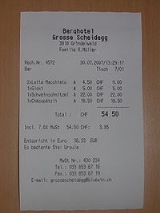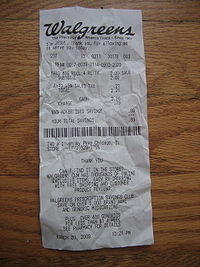
Receipt
Encyclopedia
A receipt is a written acknowledgment that a specified article or sum of money has been received as an exchange for goods or services. The receipt is evidence of purchase of the property or service obtained in the exchange.
 In English speaking countries the term most frequently applies to the printed record given to a consumer at checkout
In English speaking countries the term most frequently applies to the printed record given to a consumer at checkout
that lists the purchases made, the total amount of the transaction
including tax
es, discounts
and other adjustments, the amount paid and the method of payment
. Increasingly, these receipts may also include messages from the retailer, warranty
or return details, special offers, advertisements or coupons. Receipts may also be provided for non-retail operations such as banking transactions. A receipt is a legal document. In many countries, notably the United States of America, it is mandatory by law for retailers, and individuals, have to show receipts and store information about every receipt, so that the tax authority, or IRS can check that sales are not hidden, or something along those lines.
Printing on both sides of the receipt reduces the amount of paper used, as does reducing the size of the receipt. Special offers and advertisements printed on the receipt, take up room on the receipt, and consume extra resources, and also take longer to printout slowing down the flow of customers through the checkout.
on narrow rolls of thermal paper
. Some thermal paper contains Bisphenol A
, which, in high doses, causes impotence in men and is harmful to children, but BPA-free thermal paper is available. Recent innovations have led to multi-colored thermal printing technology and the ability to print double-sided receipts.

merchandise. Some retailers provide special "gift receipts" specifically for this purpose. Unlike a standard purchase receipt, the gift receipt omits certain information, most notably the price that was paid for an item. The receipt usually has a barcode
along the bottom so that the retailer can call up the transaction information from a database of previous purchases, authenticating a return.
Printed

Point of sale
Point of sale or checkout is the location where a transaction occurs...
that lists the purchases made, the total amount of the transaction
Financial transaction
A financial transaction is an event or condition under the contract between a buyer and a seller to exchange an asset for payment. It involves a change in the status of the finances of two or more businesses or individuals.-History:...
including tax
Tax
To tax is to impose a financial charge or other levy upon a taxpayer by a state or the functional equivalent of a state such that failure to pay is punishable by law. Taxes are also imposed by many subnational entities...
es, discounts
Discounts and allowances
Discounts and allowances are reductions to a basic price of goods or services.They can occur anywhere in the distribution channel, modifying either the manufacturer's list price , the retail price , or the list price Discounts and allowances are reductions to a basic price of goods or services.They...
and other adjustments, the amount paid and the method of payment
Payment
A payment is the transfer of wealth from one party to another. A payment is usually made in exchange for the provision of goods, services or both, or to fulfill a legal obligation....
. Increasingly, these receipts may also include messages from the retailer, warranty
Warranty
In business and legal transactions, a warranty is an assurance by one party to the other party that specific facts or conditions are true or will happen; the other party is permitted to rely on that assurance and seek some type of remedy if it is not true or followed.In real estate transactions, a...
or return details, special offers, advertisements or coupons. Receipts may also be provided for non-retail operations such as banking transactions. A receipt is a legal document. In many countries, notably the United States of America, it is mandatory by law for retailers, and individuals, have to show receipts and store information about every receipt, so that the tax authority, or IRS can check that sales are not hidden, or something along those lines.
Printing on both sides of the receipt reduces the amount of paper used, as does reducing the size of the receipt. Special offers and advertisements printed on the receipt, take up room on the receipt, and consume extra resources, and also take longer to printout slowing down the flow of customers through the checkout.
Thermal paper
Wherever credit cards and most purchases are accepted, receipts are printed using thermal printingThermal printer
A thermal printer produces a printed image by selectively heating coated thermochromic paper, or thermal paper as it is commonly known, when the paper passes over the thermal print head. The coating turns black in the areas where it is heated, producing an image...
on narrow rolls of thermal paper
Thermal paper
Thermal paper is a special fine paper that is coated with a chemical that changes color when exposed to heat. It is used in thermal printers and particularly in inexpensive or lightweight devices such as adding machines, cash registers, and credit card terminals.The surface of the paper is coated...
. Some thermal paper contains Bisphenol A
Bisphenol A
Bisphenol A is an organic compound with two phenol functional groups. It is used to make polycarbonate plastic and epoxy resins, along with other applications....
, which, in high doses, causes impotence in men and is harmful to children, but BPA-free thermal paper is available. Recent innovations have led to multi-colored thermal printing technology and the ability to print double-sided receipts.

Gift receipts
Receipts may be presented as proof of a transaction for the purpose of exchanging or returningReturning
In retail, returning is the process of a customer taking previously purchased merchandise back to the retailer, and in turn, receiving a cash refund, exchange for another item , or a store credit...
merchandise. Some retailers provide special "gift receipts" specifically for this purpose. Unlike a standard purchase receipt, the gift receipt omits certain information, most notably the price that was paid for an item. The receipt usually has a barcode
Barcode
A barcode is an optical machine-readable representation of data, which shows data about the object to which it attaches. Originally barcodes represented data by varying the widths and spacings of parallel lines, and may be referred to as linear or 1 dimensional . Later they evolved into rectangles,...
along the bottom so that the retailer can call up the transaction information from a database of previous purchases, authenticating a return.
Barcodes
Increasingly, retailers are using barcodes on receipts that allow them to identify the transaction in their system later on. This is helpful for proving the authenticity of the receipt, especially when a customer is returning or exchanging goods. Some retailers' point-of-sale systems allow the salesperson to see a complete record of the customer's buying history, including information about other store locations the customer has visited, what they purchased or returned, and total accumulated spendings, among other things- all by scanning a receipt barcode. This kind of monitoring has led to considerable savings among retailers by helping to prevent fraudulent return.Non-printed
Hand-written or hand-completed receipts are more often used for infrequent or irregular transactions, or for transactions conducted in the absence of a terminal, cash register or point of sale (for example, as provided by a landlord to a tenant for receipt of rent money.)Related industries
Organizing receipts and similar financial documents is a multi-million dollar industry in the United States. Consumers can use desktop and online software to organize electronic receipts; sometimes, receipts are sent digitally from point of sale devices to consumers. The growing trend of digital receipts has led to the launch of new businesses focused on digital receipt management.See also
- Cash registerCash registerA cash register or till is a mechanical or electronic device for calculating and recording sales transactions, and an attached cash drawer for storing cash...
- Document automationDocument automationDocument automation is the design of systems and workflow that assist in the creation of electronic documents. These include logic based systems that use segments of pre-existing text and/or data to assemble a new document. This process is increasingly used within certain industries to assemble...
in supply chain management & logistics - InvoiceInvoiceAn invoice or bill is a commercial document issued by a seller to the buyer, indicating the products, quantities, and agreed prices for products or services the seller has provided the buyer. An invoice indicates the buyer must pay the seller, according to the payment terms...
- Point of sales
- Return receiptReturn receiptA return receipt is a postal service document confirming the arrival of a message or parcel at its intended destination. Internationally, the service is known as avis de réception , but in some English-speaking countries, acknowledgement of receipt or advice of receipt is used.-Email:As applied to...

